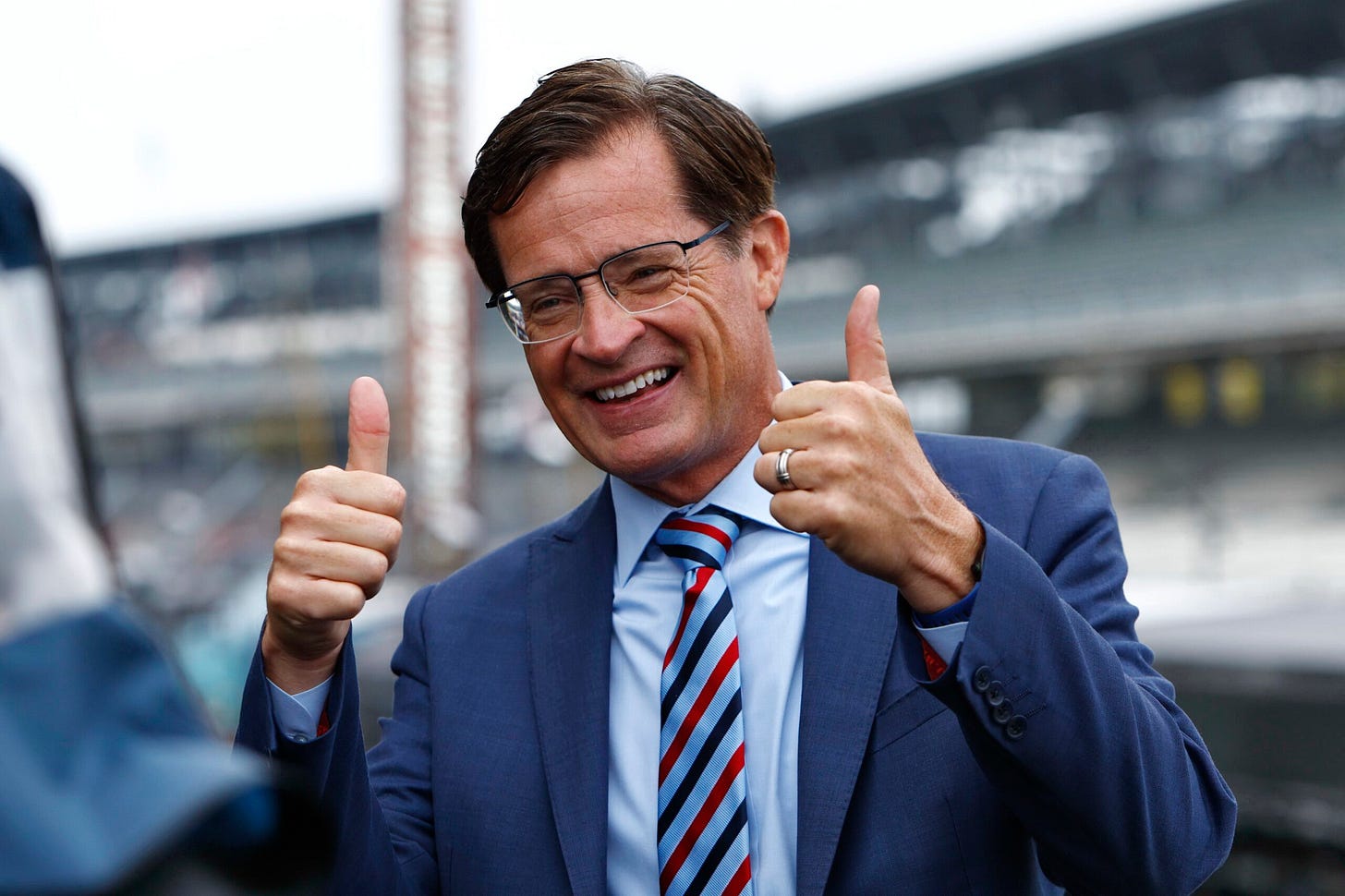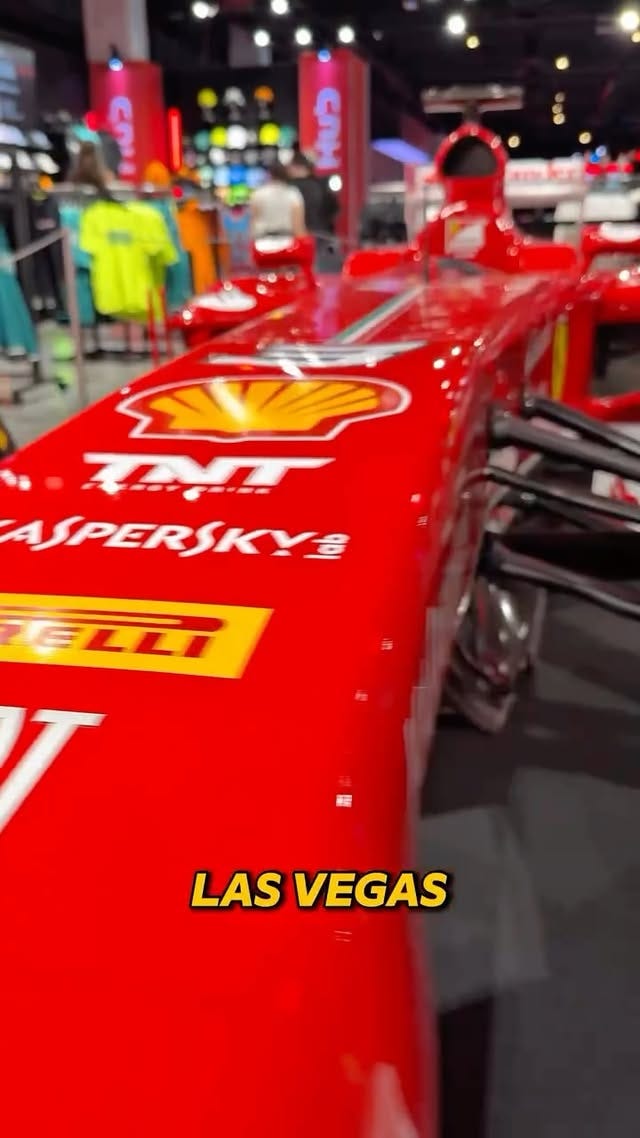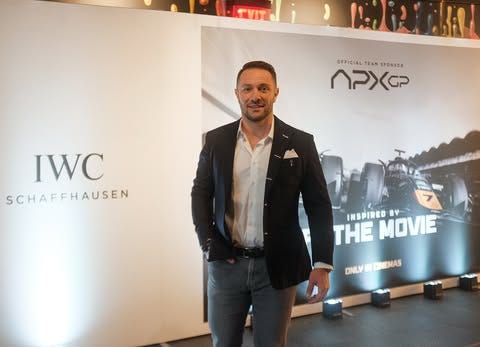IndyCar’s 364-Day Problem
Until IndyCar Solves Its Year-Round Identity Crisis, It Can’t Break Free From Its Greatest Race
You are receiving this email because you subscribed to Business of Speed, the newsletter for those wanting to stay ahead on what’s happening behind the scenes. I’m Vincenzo Landino, a business, tech, and F1 commentator. I’ve spent the last ten years at the intersection of content, partnerships, and the business of motorsport. This newsletter is where I break down what’s working, what’s shifting, and what’s next without the PR gloss. Thank you for being here.
While Formula 1 commands media rights deals exceeding $150 million and NASCAR teams sell for hundreds of millions, IndyCar's entire season struggles to compete.
Despite producing some of the most competitive racing on the planet, IndyCar faces a fundamental identity crisis that extends far beyond marketing—it's a structural problem rooted in economic dependency, technical confusion, and strategic misalignment that prevents the series from capitalizing on its competitive advantages outside of its crown jewel event.
The Indy 500 Dependency Problem
The numbers tell a stark story of feast-or-famine economics. The 2025 Indianapolis 500 drew 7.03 million viewers on NBC, while regular-season races struggled to maintain even 900,000 viewers. This represents an 87% audience drop the moment the checkered flag waves at Indianapolis Motor Speedway—a devastating cliff that no other major motorsport faces.
The financial disparity is equally pronounced. The 2025 Indianapolis 500 purse reached a record-breaking $20.3 million, with winner Alex Palou earning $3.8 million. Compare this to regular-season events, where total prize money rarely exceeds $1 million, and the structural imbalance becomes clear.
This creates a "false positive" for the series. Roughly 70% of the Indy 500 audience disappears for the next race, having moved on to "the Colts, the Pacers, frat parties, pickleball" for the remaining 364 days. What remains is a core audience of approximately 15% hardcore IndyCar fans—precisely the viewership numbers we see during regular-season races.
Unlike other sports where championship events amplify interest in the broader series, the Indy 500's unique nature has become a ceiling rather than a foundation. The race's brand equity doesn't transfer to IndyCar's road and street racing because there's a massive disconnect between the Indy 500 and the rest of the season.
The Identity Crisis That's Killing Growth
IndyCar suffers from schizophrenic positioning that confuses fans, sponsors, and participants. Is it a spec series focused on driver skill or an OEM-driven championship showcasing manufacturer technology? The answer reveals a series caught between two incompatible visions.
The current technical regulations exemplify this confusion. IndyCar has used the same Dallara chassis exclusively since 2012—a design that's now 13 years old and has become a bone of contention throughout the paddock. The promised replacement, initially scheduled for 2026, has been repeatedly delayed and now won't arrive until 2028. Teams can develop suspension components and aerodynamic details, but 95% of the car remains identical.
This creates a formula that's too restricted to generate meaningful manufacturer differentiation, yet too open to ensure pure driver competition. Compare this to Formula 1, where constructor identity drives fan engagement and justifies billion-dollar team valuations. IndyCar's cars are essentially indistinguishable to casual observers beyond engine manufacturer stickers.
The result is a series that lacks the technological mystique of Formula 1 and the manufacturer storylines of NASCAR while failing to deliver the pure competition narrative of a true spec series.
New Leadership, New Hope?
There's cautious optimism in the paddock following the appointment of J. Douglas "Doug" Boles as IndyCar president in 2025. The former Indianapolis Motor Speedway president brings a different energy compared to his predecessor, Mark Miles, who was widely considered old school in his approach.
Boles' track record at IMS—where he successfully modernized the Indianapolis 500 experience while maintaining its traditions—suggests he understands how to balance innovation with heritage. His appointment represents the series' most significant leadership change in years, though the structural challenges he inherits remain daunting.
Media Rights and the Fox Sports Gamble
The media rights disparity reveals IndyCar's fundamental commercial challenges. IndyCar's entire annual media rights deal ($20 million) is dwarfed by Formula 1's US-only package, with Apple reportedly bidding $150 million annually for American F1 rights alone.
IndyCar's 2025 move to Fox Sports represents both opportunity and risk. The deal, reportedly worth more than $25 million annually, provides 100% network television coverage for the first time in series history.
Fox's Strategic Approach
Early signs suggest Fox understands the assignment. Their marketing has centered on driver stories, with Super Bowl spots showcasing Josef Newgarden, Alex Palou, and Pato O'Ward—finally attempting to create "heroes" for casual fans to follow. For the first time in series history, every broadcast includes driver introductions, and drivers' faces appear on the timing tower during races.
Fox has also adopted Formula 1's language, replacing confusing "alternate/primary" tire designations with intuitive "soft/hard" terminology. They've incorporated "ghost car" technology and explainer videos to help new viewers understand the sport's complexities.
However, this strategy assumes NASCAR audiences will convert to IndyCar viewing—an assumption that ignores fundamental differences in fan bases. NASCAR fans are drawn to stock car racing's intense contact and Americana branding, while IndyCar offers precision, international drivers, and road racing emphasis.
IndyCar's previous streaming experiments on Peacock proved disastrous, with viewership so low that numbers weren't included in annual ratings averages. The series' 70% over-55 demographic remains anchored to traditional television consumption, unlike F1's success in attracting younger viewers through Netflix's "Drive to Survive."
The "Anyone Can Win" Paradox
IndyCar's traditional marketing emphasized unpredictability: "You never know who will win!" This narrative worked when the series delivered on that promise. But what happens when you have dominant seasons like Alex Palou's 2025 championship run?
The series finds itself in a marketing bind. Years of promoting parity make it challenging to celebrate individual excellence when it emerges. Formula 1 thrives on driver dynasties and team dominance—it creates storylines and rivalries that transcend individual races, fostering a sense of continuity and legacy. IndyCar's parity-focused messaging struggles to adapt when dominance occurs.
The Charter System: Limited Value Creation
IndyCar's introduction of the 2024 charter system represents the series' most significant structural change in years, but it arrives too late. Each charter is estimated to be worth $1 million—a figure that pales compared to NASCAR charters selling for $20-40 million or Formula 1 team valuations exceeding $2.5 billion.
The Leaders Circle program distributes $910,000 to $1,060,000 annually to the top 22 finishers. While meaningful for team budgets, these payouts represent survival funding rather than growth capital. Teams receive sufficient funding to continue participating but lack the necessary resources to invest in competitive advantages or marketing initiatives.
The charter system's design reveals IndyCar's limited commercial ambition. By excluding the Indianapolis 500 from charter protection, the series acknowledges that its crown jewel operates under different economic principles, effectively codifying the two-tier system that undermines series-wide growth.
Liberty Media's Playbook vs. IndyCar's Stagnation
Liberty Media's Formula 1 transformation since 2017 serves as a masterclass in motorsport commercialization. Liberty increased F1's annual revenue by 91.2% from 2017 to 2024 while expanding global reach and fan engagement.
Liberty recognized that Formula 1 needed to become a cultural phenomenon, not just a racing series. The company invested heavily in "Drive to Survive" content creation, Las Vegas spectacle, and social media engagement, attracting audiences beyond traditional motorsport fans.
IndyCar remains fixated on the racing product itself. While competitive balance and exciting finishes matter, they've failed to develop cultural narratives that resonate with mainstream audiences. Liberty Media transformed F1's business model from broadcast-centric revenue to a diversified entertainment experience, while IndyCar's revenue model remains anchored in 1990s thinking.
The Sponsorship Problem
Major brands increasingly view IndyCar as a poor return on investment. Recent financial disclosures reveal the challenge: Lottery.com's IndyCar sponsorship deal totaled just $30,000 for helmet branding. For context, Formula 1 sponsorship deals regularly exceed $50 million annually for significant partnerships.
IndyCar's 900,000 average viewership pales compared to F1's 1.3 million US average and NASCAR's considerably larger domestic audience. More importantly, IndyCar's audience demographics skew older and less affluent than brands targeting growth segments.
IndyCar's response has been redirecting team prize money into marketing budgets. In 2023, Penske Entertainment reduced the Leaders Circle contract by $150,000, redistributing $3.3 million to internal marketing efforts. This treats marketing as an expense rather than an investment, reflecting short-term thinking that undermines long-term growth.
The Path Forward
IndyCar's challenges require fundamental strategic realignment rather than incremental improvements. The series must choose between two distinct paths: embrace spec racing's pure competition narrative or commit fully to manufacturer-driven technical development.
The Spec Series Solution could position IndyCar as motorsport's ultimate driver championship, emphasizing skill over technology. This would require a single-engine supplier, identical chassis, and minimal development spending. The resulting cost reduction could enable larger fields, international expansion, and driver-focused marketing narratives.
The Manufacturer Championship Alternative would embrace meaningful technical competition between manufacturers, requiring open development restrictions, multiple chassis suppliers, and genuine technological differentiation. Higher costs could be justified through increased manufacturer investment and enhanced sponsor value propositions.
The Clock Is Ticking
IndyCar stands at a crossroads where incremental changes won't solve structural problems. The series' aging fan base, limited commercial appeal, and fundamental identity confusion require bold strategic decisions that challenge decades of conventional thinking.
Doug Boles' leadership and Fox Sports' commitment to driver storytelling represent positive steps, but they're addressing symptoms rather than causes. The series needs visionary leadership willing to make difficult strategic choices about its future identity and commercial model.
Formula 1's transformation demonstrates that motorsport properties can reinvent themselves when leadership commits to long-term vision over short-term survival. IndyCar possesses competitive racing, iconic venues, and passionate core fans—the raw materials for commercial success.
However, the window for transformation is narrowing. As Formula 1 expands its American footprint and NASCAR modernizes its approach, IndyCar risks being relegated to a niche status. The question isn't whether IndyCar can produce exciting racing—it already does. The question is whether the series can evolve beyond its current limitations to become a commercially viable entertainment property that attracts mainstream audiences, major sponsors, and long-term investment.
The Indy 500 will always be special. But until IndyCar solves its 364-day problem, it will remain trapped in the shadow of its own greatest achievement.
And if you enjoyed this breakdown, subscribe to Business of Speed for more on the business behind Formula 1 and motorsport. Let's connect the dots. And, if you're a brand eyeing motorsport or looking to get more out of your current motorsport partnership, let’s work together.
IS YOUR MOTORSPORT INVESTMENT ACTUALLY MOVING THE NEEDLE?
MOST MOTORSPORT SPONSORSHIPS ARE JUST EXPENSIVE LOGO PLACEMENT.
YOURS DOESN'T HAVE TO BE.
FREE Speed Audit Reveals:
✅ The hidden ROI gaps in your current motorsport strategy
✅ 3 immediate opportunities to amplify your racing investment
✅ Your "Sponsorship Performance Score"
✅ A custom action plan to turn exposure into engagement
Field Notes
I attended a screening of the F1 Movie with IWC and then jumped on a plane to Las Vegas after being invited to check out the Grand Prix Plaza.






